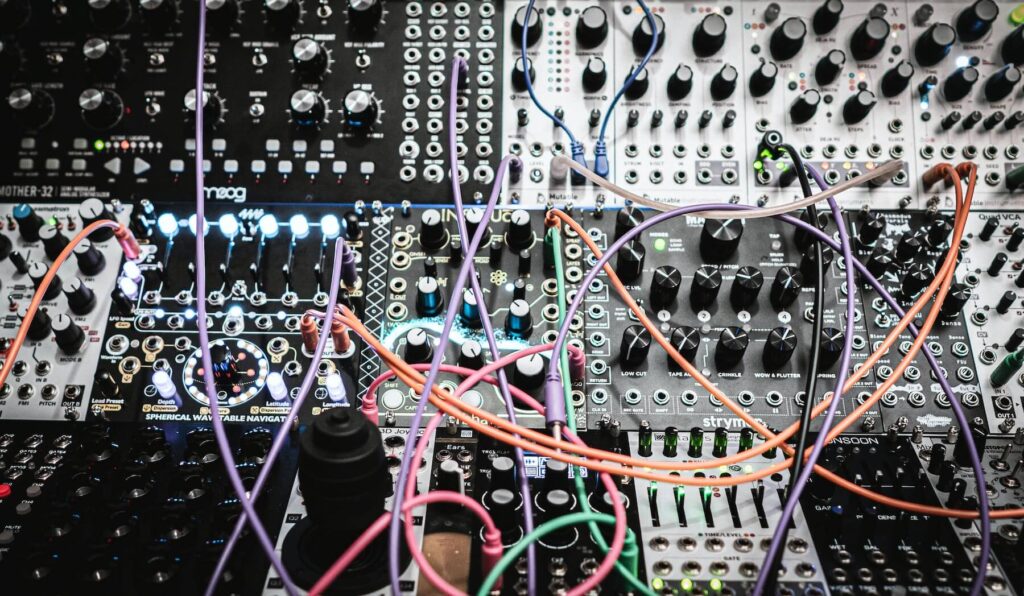Modular Synthesis
The past ten years has seen a rise in modular synthesis (largely through the Eurorack format pioneered by the German company Doepfer). Below is a guide to what is modular synthesis with some helpful links into how to get started.

Modular synthesis is a method of sound synthesis in which the synthesizer is composed of separate modules, each with a specific function. These modules can be connected together in various ways to create complex sounds and musical compositions. Here’s a comprehensive overview of modular synthesis:
Key Components of Modular Synthesis
- Modules:
- Oscillators (VCO): Generate raw waveforms (sine, square, sawtooth, triangle) that serve as the basic sound source.
- Filters (VCF): Shape the timbre of the sound by attenuating certain frequencies. Common types include low-pass, high-pass, band-pass, and notch filters.
- Amplifiers (VCA): Control the amplitude (volume) of the sound, often modulated by envelopes or other control voltages.
- Envelope Generators (EG): Produce control voltages that change over time, typically used to modulate VCA or VCF. Common envelope types are ADSR (Attack, Decay, Sustain, Release).
- Low-Frequency Oscillators (LFO): Generate slow, periodic waveforms used to modulate other parameters, such as pitch, filter cutoff, or amplitude.
- Sequencers: Generate sequences of control voltages to create rhythmic patterns and melodies.
- Mixers: Combine multiple audio or control signals into one.
- Noise Generators: Produce white, pink, or other types of noise used for percussive sounds or modulation sources.
- Effects Modules: Add effects like reverb, delay, chorus, and distortion to the sound.
- Patch Cables:
- Connect modules together, allowing signals to flow from one module to another. The way modules are connected (patched) determines the signal path and ultimately the sound produced.
- Control Voltage (CV):
- Analog signals that control various parameters of the modules. For example, an LFO might send a control voltage to an oscillator to modulate its pitch.
How Modular Synthesis Works
- Signal Flow: Unlike fixed-architecture synthesizers, where the signal path is predetermined, modular synthesizers allow users to create their own signal flow by connecting modules with patch cables. This provides enormous flexibility and creativity in sound design.
- Modulation: Modulation is a core concept in modular synthesis. It involves using one module to control another, which can result in dynamic and evolving sounds. Common modulation sources include LFOs, envelopes, and sequencers.
- Sound Design: By combining various modules and adjusting their parameters, users can create a vast array of sounds, from simple tones to complex textures.
Advantages of Modular Synthesis
- Flexibility: Users can create unique and complex signal paths tailored to their specific needs.
- Expandability: Modular systems can be expanded over time by adding new modules, allowing for continuous growth and exploration.
- Hands-On Control: Physical knobs, sliders, and patch cables provide a tactile and intuitive way to interact with the synthesizer.
- Creativity: The open-ended nature of modular synthesis encourages experimentation and exploration, often leading to unexpected and innovative sounds.
Disadvantages of Modular Synthesis
- Cost: Modular systems can be expensive, especially as more modules are added.
- Complexity: The learning curve can be steep for beginners, requiring a deep understanding of synthesis concepts and signal flow.
- Space: Modular setups can take up a significant amount of physical space.
Popular Modular Formats
- Eurorack: The most popular modular format, known for its compact size and wide range of available modules from numerous manufacturers.
- 5U (Moog Unit): Larger format modules, often used for their robust build and classic analog sound.
- Buchla: Known for its unique approach to synthesis and innovative module designs.
- Serge: Another classic format with a focus on complex and experimental sound design.
Applications of Modular Synthesis
- Sound Design: Used extensively in film, TV, and game sound design for creating unique soundscapes and effects.
- Music Production: Employed by musicians and producers to create distinctive sounds and compositions.
- Live Performance: Modular synthesizers are popular in live electronic music performances due to their hands-on control and visual appeal.
- Research and Education: Used in academic settings to teach synthesis concepts and for research in electronic music.
Getting Started with Modular Synthesis
- Research: Learn about the different types of modules and their functions. Online forums, tutorials, and communities can be valuable resources.
- Start Small: Begin with a few basic modules (oscillator, filter, VCA, envelope, LFO) and expand as you gain more experience.
- Experiment: Spend time experimenting with different patch configurations to understand how modules interact.
- Budget: Plan your budget carefully, as modular synthesis can quickly become expensive.
Modular synthesis offers a highly customizable and interactive approach to sound creation, making it a powerful tool for both seasoned professionals and adventurous newcomers.
